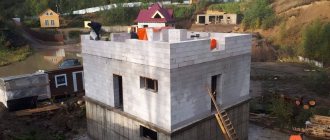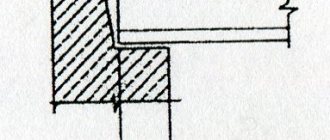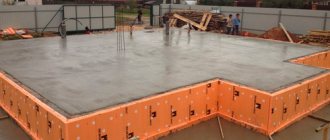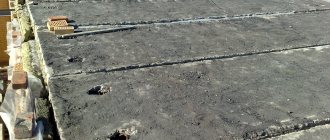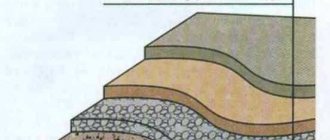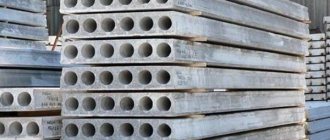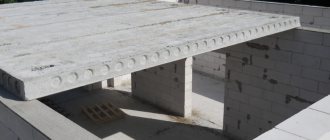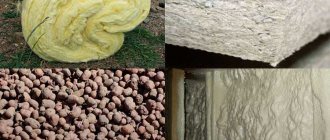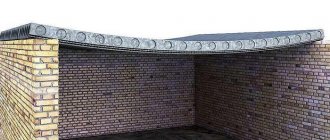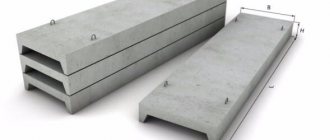If you are a builder, you have probably often encountered problems that are usually associated with cement mortars. Dust, instability in cold weather, varying shrinkage and subsidence, poor thawing, abrasion and cracks, cracks, cracks. It is almost impossible to do without this, which is why, wherever possible, most people try to replace cement mortar with some analogue: dry screed, wooden walls, unusual construction. But recently, a new mixture – concrete and fiber fiber – has become increasingly popular.
First of all, we recommend that you watch a video about this wonderful building material:
- 2 What are the advantages of fiber foam concrete floors?
- 3 How to make fiber foam concrete at home?
- 4 How to make a screed from fiber foam concrete?
- 5 How to pour screed on the foundation?
- 6 Fiber foam concrete floor slabs
What is fiber foam concrete?
This discovery occurred thanks to a whole series of studies of concrete batches. And it turned out that foam concrete, to which fiber is added during manufacturing, becomes an excellent material: warmer and lighter than wood, but at the same time harder and much more durable. And it turned out that floors made from such a screed are especially warm and durable, almost never crack and are perfectly processed. We can say that all those problems that used to be so annoying when working with ordinary concrete screed can finally be forgotten.
Essentially, fiber is a polypropylene fiber that is designed to reinforce concrete and mortar made of cement and gypsum. Any screed from such an additive acquires the necessary ductility and good resistance to stretching and impact. And also - stability and uniformity are much better than conventional mixtures.
Not a single chemical additive can boast of what fiber fiber does for floor screed - creating three-dimensional volumetric reinforcement for it. Fiber fiber in foam concrete allows it to crystallize cement stone in a directional manner, without lumps, firmly and without shrinkage. The entire structure of foam concrete is optimized, and the risk of internal defects is significantly reduced.
For floors, fiber fiber works as a cheaper, but no less high-quality replacement for steel reinforcing mesh, and when laying concrete, it acts as an additional reinforcing element. Thanks to the presence of fiber fiber in the screed, the floors shrink without cracks, and ultimately turn out to be much more durable and impact-resistant. There are research results confirming that the use of fiber:
- reduces product defects by up to 90%;
- increases the resistance of the floor to abrasion by 60%;
- 5 times - to splitting;
- increases frost resistance;
- 35% - waterproof;
- up to 70% - compressive bending strength;
- Up to 35% - impact resistance;
- Up to 90% - destruction of concrete, there will be no chips or fragments.
Fiber fiber works like this: in the critical period of 2-6 hours after laying the floor, this reinforcing element increases the ability of the solution to deform without destruction, and after final hardening during the shrinkage process, the fibers connect the edges of possible cracks, and the risk of fracture is much lower. Such a floor will also emit less water, which means a valuable reduction in internal load.
For comparison: fiber in any concrete solution eliminates the formation of shrinkage cracks by 60-90%, while reinforcing mesh eliminates the formation of shrinkage cracks by only 6%. Moreover, fiber fiber is absolutely resistant to all chemical additives that are already in concrete. It has excellent heat resistance, no corrosion and no need for high-speed mixers.
The minimum dose of fiber fiber in fiber foam concrete is 600 g/m3. And a dosage of 900 g/m3 allows you to increase the strength of the screed by as much as 25% and reduce the amount of cement by up to 7%.
Use fiber fiber 12 mm long to make floors - this is what builders recommend. But fibers 18 m and 6 mm long are intended for completely different types of construction. Propex fiber fiber is considered the highest quality today - it does not form lumps, allows for good sanding of floors and reduces the risk of cracking when the solution shrinks by up to 90%.
ELEMENTS OF ARCHITECTURAL DECOR FROM FIBROFOAM CONCRETE
Thanks to fiber foam concrete's high tensile strength in bending and frost resistance (F75, F100), it has become possible to produce lightweight architectural decorative elements for outdoor installation. These products can have a reinforcing metal frame and embedded elements for welding and combine low weight with transportability and durability.
BAZA SM LLC offers cornices and beams already mastered in production:
We accept orders for the manufacture of products according to customer drawings.
FIBROFOAM CONCRETE USED IN THE CONSTRUCTION OF MORE THAN 300 FRAME-MONOLITHIC HOUSES OF UP TO 24 STORIES.
What are the advantages of fiber foam concrete floors?
So what is so good about newfangled fiber foam concrete floors? See for yourself:
- Porous structure. And this is excellent sound and heat insulation, which is what is most valuable for floors.
- Perfectly flat surface. In fiber foam concrete, due to the presence of fiber reinforcement, there are no lumps, and after complete shrinkage, the floors are perfectly flat.
- Easy styling, even by professional hands.
Due to the special fluidity of this material, it can fill any void spaces, even in the most inaccessible places - window sills, pipes. For such a floor, a vibration compactor is not needed, because There is almost no shrinkage as such. And most of all, fiber foam concrete is valuable for its load distribution characteristics.
Also, floors made of fiber foam concrete have high fire resistance. Even when exposed to a blowtorch, such a screed will not split or explode, as heavy concrete can do. In addition, not long ago an interesting experiment was conducted in Australia: a foam concrete wall only 15 cm thick was heated to 12,000°C, but even after a full 5 hours of testing it barely reached 460°C. And even then the material did not emit any harmful substances when heated, but we are forced to cover ordinary concrete structures with basalt wool and plastic for insulation, which is literally fatal when a fire starts.
Even in severe frosts and in an unheated room, the surface of such a floor will have a temperature of 2-5 ° C - all thanks to the thermal conductivity coefficient of concrete, which is 2.5 times less than that of a conventional concrete screed. And the lower this indicator, the warmer the floor will be.
In fact, a screed made of fiber foam concrete is similar in its properties to light and durable artificial stone.
The advantages of fiber foam concrete acquired during the reinforcement process
- The fiber frame distributes the load throughout the entire volume of the wall blocks.
- Due to the ideal geometry of the blocks, smooth walls can be erected.
- It is resistant to high humidity. Does not get wet even when in contact with water.
- Allows installation of communications (pipes, electrical networks), both open and hidden.
- Holds heavy objects (pictures, cabinets, shelves) well to the wall.
- Fiber foam block is applicable for the construction of three-story houses without a reinforcement belt.
- Allows you to reduce the thickness of walls (compared to brick) by 3 times.
- Reduces costs for building materials by 4 times.
Apartment renovation
Walls and floor
Landscape design
How to make fiber foam concrete at home?
Here's how you can make fiber foam concrete for pouring floors if you have the necessary equipment - you can add fiber fiber in two ways:
- Method 1. Pour into a construction mixer, into a dry mixture without water - this way the fiber is distributed better. Just add fiber in parts while mixing.
- Method 2. Add directly during kneading.
So, method one:
Step 1. Connect the equipment. Check the direction of rotation - it should be counterclockwise. Step 2. Fill in water (calculate in advance, based on the water absorption of the sand used) and start. Step 3. While the equipment is operating, load the following components:
- Cement.
- Sand.
- Foaming agent 150-300 g.
- Fiber fiber 30-50 g.
And close the hatch hermetically. Immediately press the “Stop” button, followed by the “Start” button, and count down the time using the timer. Step 4. Set the pressure to 1.8 ATM using the pressure gauge and close the air supply valve. Step 5. Wait for about 3 minutes for the kneading to finish and fill the floors.
Method two:
- Step 1. Pour sand into the mixer and immediately mix in the water from the previous mixture.
- Step 2. Now - cement, and mix everything thoroughly until the mixture becomes a uniform color. This is a crucial stage.
- Step 3. Mix the mixture with water according to the chosen recipe. Mix everything again until you get a homogeneous plastic mass.
- Step 4. Add fiber fiber, exactly 0.1% of the mass of foam concrete. By the way, you can change the dosage depending on the desired final quality. When stirred, the fiber fiber will distribute itself throughout the mixture.
What are the advantages of such an additive: fiber fiber does not need to be fluffed or mixed with water in advance. But combining with other additives is easy.
How to make a screed from fiber foam concrete?
There are standards for the manufacture of such floors. So, these are the requirements of GOST 25485 - 89 “Cellular Concrete” and GOST 13.015.0 - 83.
Fiber foam concrete for pouring floors is made quickly and simply. That is why today construction crews charge only about 2,500 rubles/m3 for such floors. In addition, such technology also does not require additional labor or complex equipment - everything is much simpler.
Floors must be poured using a special mobile unit with a capacity of 2-6 m3/hour. The hoses should be up to 30 m vertically and up to 60 m horizontally - so that the solution does not get stuck anywhere.
As additional protection against cracking, you can use beacons made of moisture-resistant plywood. Place them in 1-2 meter increments. After pouring, you can safely leave them directly in the floor - this way they will act as damping joints.
Now it is important to create the correct temperature and humidity conditions for the screed, namely, cover the concrete with plastic film. In a week, at a temperature of 22°C, the foam concrete will gain up to 70% of its brand strength.
As a result, a homogeneous monolithic layer is obtained on the surface of the ceiling, which easily conceals all irregularities, is quite warm and environmentally friendly. According to experienced builders, you can walk on fiber foam concrete floors already on the fourth day, and such a foundation gains full strength after 28 days.
Here is an example of what type of floor is installed on an uneven base:
By the way, the most effective is considered to be a combined option, when fiber foam concrete with a density of 300-500 kg/m3 is used for the lower thermal insulation layer, and with parameters of 600-1200 kg/m3 as the top one. But for the reconstruction of buildings, fiber foam concrete with a density of 800 kg/m3 is used, which makes the floors in apartments warm and smooth.
And for greater insulation they are also poured like this:
Fiber foam concrete as a finishing screed for floors is also good because it is quite light and does not create additional load. You will also be pleased with the fact that such a screed does not create any dust, and it is very convenient to work with it.
INTER-Apartment and INTERROOM PARTITIONS
A block of 588x288x188mm with a density of 600 kg/m3 is proposed as a wall material for the inter-apartment partition and fencing of staircases and landings. A sample design consisting of these blocks is presented below. The fire resistance limit of this design is RI120, the airborne noise insulation index is 52 dB.
For the installation of interior partitions, including those used in rooms with a humid environment, a block of 588x288x100mm with a density of 600 kg/m3 is used. The content of the reinforcing component is sufficient so that the block is not brittle, even with a thickness of 10 cm. Due to its porosity, the material has good sound insulation: for example, a partition made of blocks has an airborne noise insulation index of 43 dB. A sample of an interior partition is presented below.
How to pour screed on the foundation?
Everything here is as usual - formwork, ditch, pouring. And the screed device itself is quite simple. The next day after grouting, smooth the floor with special equipment, and after grouting, maintain moisture for a week. To do this, moisten the screed three times a day and cover with plastic wrap.
And if you add a cement-sand screed on top of the fiber foam concrete, then such a floor will have especially high strength characteristics.
And over the years, floors made of fiber foam concrete only improve their strength and thermal insulation properties - all due to long internal maturation. Therefore, you don’t have to worry about the strength of such a foundation.
Advantages
The advantages of fiber foam concrete significantly outweigh its disadvantages. Benefits include:
Additional warmth of structures due to the ability of the material to accumulate heat. This property allows you to save on heat-insulating materials and heating devices. Accelerated work process, which occurs due to the large size of the blocks. The speed of masonry increases and the cost of construction decreases due to the use of special glue. Increased resistance to impact and abrasion. The reliability inherent in fiber foam concrete makes the building durable. The material does not rot and has high strength. Sound insulation. The material has the property of absorbing sound waves, which ensures silence in the room. Eliminates the occurrence of plastic deformations and cracks. The material is economical due to its size, which allows reducing the consumption of laying mortars and the thickness of the plaster layer.
Indoor microclimate. Fiber foam concrete reduces heat loss in the cold season and provides a comfortable temperature in the summer. The material is not exposed to dampness and controls the level of humidity. Convenient transportation due to the ratio of weight and volume. Fiber foam concrete ensures environmental friendliness of the premises, since it does not emit toxic components during operation. The fire safety of the material refers to the 1st degree of fire resistance. When the fire is open, it does not lose its strength characteristics and does not release toxins. As a result of this, it is recommended to use fiber foam concrete for buildings and structures where materials subject to strong combustion are planned to be stored. Due to the ideal geometric parameters of the blocks, smooth walls can be erected. Does not require plastering. Good fixation of heavy objects to the wall. Application in various fields of construction.
Currently reading: Antifreeze for concrete (antifreeze additives, antifreeze, antifreeze liquid)
Fiber foam concrete, due to its warmth, lightness and strength, is better than standard foam concrete.
Return to contents

